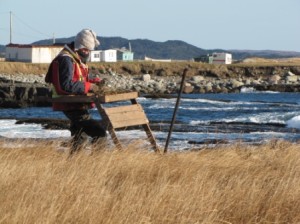Archaeological Screening & Reconnaissance for the Maritime Link Transmission Project
Newfoundland and Cape Breton
 NSP Maritime Link (NSPML) Inc. is developing the Maritime Link Transmission Project, a new 500 megawatt electrical power transmission system between the Newfoundland and Cape Breton. The Maritime Link involves the construction and operation of a new 300 km transmission line between Cape Ray and Granite Canal by way of Bottom Brook, two subsea cables spanning approximately 180 km from Cape Ray, Newfoundland to Point Aconi, Nova Scotia; and, a new 50 km transmission line between Point Aconi and the Woodbine substation in Cape Breton. The system includes: transmission corridors; subsea cables; shore grounding facilities; two converter stations and adjoining substations; two transition compounds (for converting underground subsea cables to overhead transmission conductors); and, other potential infrastructure, as required.
NSP Maritime Link (NSPML) Inc. is developing the Maritime Link Transmission Project, a new 500 megawatt electrical power transmission system between the Newfoundland and Cape Breton. The Maritime Link involves the construction and operation of a new 300 km transmission line between Cape Ray and Granite Canal by way of Bottom Brook, two subsea cables spanning approximately 180 km from Cape Ray, Newfoundland to Point Aconi, Nova Scotia; and, a new 50 km transmission line between Point Aconi and the Woodbine substation in Cape Breton. The system includes: transmission corridors; subsea cables; shore grounding facilities; two converter stations and adjoining substations; two transition compounds (for converting underground subsea cables to overhead transmission conductors); and, other potential infrastructure, as required.
 As part of the environmental assessment (EA) process, NSPML retained the services of Cultural Resource Management (CRM) Group Limited to undertake high level archaeological resource screening and reconnaissance of the proposed corridors, as well as the ancillary facilities, in both Newfoundland and Cape Breton. Between August of 2011 and September of 2013, CRM Group conducted the screening and reconnaissance, which included background research, the development and application of an archaeological potential model, field reconnaissance and field-truthing. Since much of the Newfoundland component of the transmission line was not easily accessible, helicopter reconnaissance became a crucial element in the initial screening and field truthing. The archaeological screening and reconnaissance components of the EA were undertaken in accordance with archaeological legislation specific to either Newfoundland & Labrador or Nova Scotia. In addition to the documentation prepared specifically for the EA process, CRM Group prepared permit specific reports for Newfoundland & Labrador’s Provincial Archaeology Office and Nova Scotia’s Special Places Program.
As part of the environmental assessment (EA) process, NSPML retained the services of Cultural Resource Management (CRM) Group Limited to undertake high level archaeological resource screening and reconnaissance of the proposed corridors, as well as the ancillary facilities, in both Newfoundland and Cape Breton. Between August of 2011 and September of 2013, CRM Group conducted the screening and reconnaissance, which included background research, the development and application of an archaeological potential model, field reconnaissance and field-truthing. Since much of the Newfoundland component of the transmission line was not easily accessible, helicopter reconnaissance became a crucial element in the initial screening and field truthing. The archaeological screening and reconnaissance components of the EA were undertaken in accordance with archaeological legislation specific to either Newfoundland & Labrador or Nova Scotia. In addition to the documentation prepared specifically for the EA process, CRM Group prepared permit specific reports for Newfoundland & Labrador’s Provincial Archaeology Office and Nova Scotia’s Special Places Program.
 In the fall of 2013, CRM Group was again retained by NSPML to address archaeological recommendations related to the Cape Breton components of the project. Throughout the fall, CRM Group conducted location specific reconnaissance and shovel testing related to tower placement and facility siting. Building upon the earlier archaeological potential modelling and field truthing, CRM Group was able to significantly reduce the overall number of tower locations to be shovel tested.
In the fall of 2013, CRM Group was again retained by NSPML to address archaeological recommendations related to the Cape Breton components of the project. Throughout the fall, CRM Group conducted location specific reconnaissance and shovel testing related to tower placement and facility siting. Building upon the earlier archaeological potential modelling and field truthing, CRM Group was able to significantly reduce the overall number of tower locations to be shovel tested.

